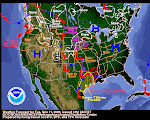"California is facing the most significant water crisis in its history. After experiencing two years of drought and the driest spring in recorded history, water reserves are extremely low. With the Sacramento-San Joaquin Delta ecosystem near collapse, court-ordered restrictions on water deliveries from the Delta have reduced supplies from the state's two largest water systems by twenty to thirty percent.
Drought conditions in the Colorado River Basin and a Sierra snowpack that is now dangerously unreliable due to global climate change, is leaving many communities throughout California facing mandatory restrictions on water use and/or rising water bills. If the drought continues into next year, the results could be catastrophic to our economy." Go to the website where we found this snippet.
The above map linked from the Climate Prediction Centers says it all--NORCAL is at ground zero of a genuine water crisis. Right now, tonight, even as we write this blog post, NORCAL might just be getting a "get out of jail" pass and California might dodge an intergalactic bullet. NORCAL is getting plastered tonight.
Above you see the water vapor blanketing the most hard hit part of drought stricken California. Below, you see a screen shot of the next few days of accumulated precipitation this area. At this point in time, it really can't get a whole lot better than this!































